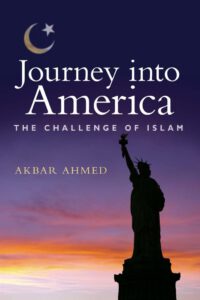 The chasm between Muslims and non-Muslims in America has become glaring. I should know, since creating a cartoon about censorship entitled “Everybody Draw Mohammed Day,” I have been experiencing the conflict first-hand.
The chasm between Muslims and non-Muslims in America has become glaring. I should know, since creating a cartoon about censorship entitled “Everybody Draw Mohammed Day,” I have been experiencing the conflict first-hand.
Practically every day now, I hear about people picketing mosques and of Muslims feeling persecuted. Just in time, Akbar Ahmed’s Journey into America: the Challenge of Islam has arrived.
Mr. Ahmed’s premise is that America must build a new identity. By glossing over our history of slavery or by perhaps clinging to myths about the Mayflower and Plymouth Rock, many Americans have held to an identity that is way past its pull date.
This, Ahmed suggests, contributes to our country’s descent into a financial, moral and intellectual morass while we blindly chant “We’re number one!”
According to Mr. Ahmed, America’s return to glory depends directly on whether our Muslim and non-Muslim communities can get along.
Chair of Islamic Studies at American University in Washington, D.C., former Pakistani high commissioner to the United Kingdom and Distinguished Chair of Middle East and Islamic Studies at the U.S. Naval Academy – Mr. Ahmed is so even-handed about issues that even a reader who, like me, has been resistant to welcoming a religion so seemingly alien can become completely open to both knowledge and criticism.
Read the full review after the jump.
The author led me to a place where I became humbled regarding truths about my country and its history. Truths such as our xenophobic immigration laws before the 1965 Hart-Cellar Act, or the fact that Presidents Andrew Jackson and Theodore Roosevelt “helped redefine primordial identity by fusing it with predator identity.”
Journey chronicles the author and some of his students as they proceed on an anthropological quest, visiting one-hundred mosques in seventy-five cities over a year’s time. The crew conducts interviews and hands out questionnaires while Ahmed lectures about Muslim-non-Muslim relations along the way. By including the opinions of his students, the author keeps the narrative fresh.
The team visits with Muslims and non-Muslims, Jews, Mormons, immigrant Muslims from both the Middle East and Southeast Asia, and Native Americans, among others. They ask for opinions on topics such as social excess, foreign policy, terrorism, religion and even the popular American phenomenon Girls Gone Wild! The author devotes entire chapters to the relationships many of these groups have with Muslims, presenting a substantial cross-section of Americans whose photographs are sprinkled throughout the book.
Mr. Ahmed conducts his survey of American Muslims within the framework of three identities of American society: primordial, pluralist and predator. He writes, “These three American identities overlap and derive from the same source – namely, the first white settlers at Plymouth, and to a certain extent those at Jamestown. […] The story of America must be read as the story of these identities and their struggle to form the dominant narrative.”
The author writes affectionately about the principles that Founding Fathers wrote into the constitution and many of their contemporaries who embody the pluralist identity by, for example, laying foundations for future civil rights, fighting for the separation of church and state and defending the rights of Native Americans. The world looks up to us, writes the author, “…because of America’s unique vision of society formulated by its Founding Fathers and encapsulated in its founding documents.”
Each chapter is filled with information about Muslims that I was completely unaware of. Particularly fascinating is a chapter entitled “African-Americans as First Muslims.” African-American Muslims tend to follow a more open translation of Islam versus immigrant Muslims from the Middle East and Southeast Asia, whose interpretations can be more rigid. Immigrant Muslims are often not as involved in America. In fact, the author states numerous times how shocked he is by how little many immigrant Muslims know about American culture. On the other hand, assimilated African-American Muslims are willing to work on social issues such as poverty, racism and inner city problems.
Troubling instances in the book include a visit to the Universal School in Buffalo, New York, a Muslim school with an enrollment of about 100 girls and boys, where the students voice their desire for Sharia law in the United States. Another concerning incident occurs when the team interviews a Salafi Muslim who answers their question “What does it mean to be American?” with “Nothing…the three most important places in the world for me are Mecca, Medina and Jerusalem. America might as well be another country.”
“We fail to recognize,” the author writes, “the importance of America in that it alone has the capacity to mobilize the world to tackle [these] daunting tasks. But it cannot do so without resolving the question of its identity. The challenge of Islam is to help America find that identity and enable it to fulfill its destiny.”
What will you do to bridge Muslim and non-Muslim communities today? I suggest sharing food, that most delicious form of patriotism.
Written by Molly Norris, a freelance writer and cartoonist who lives in Seattle.
(cityartsmagazine)













